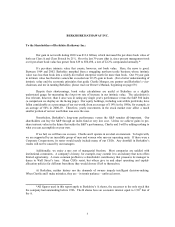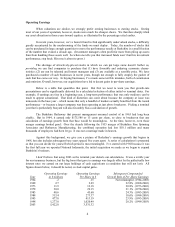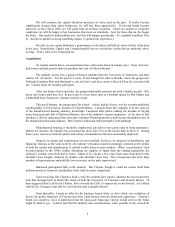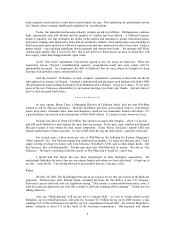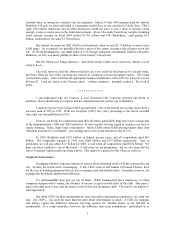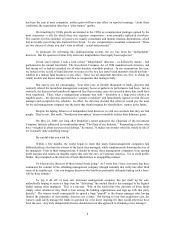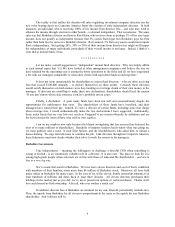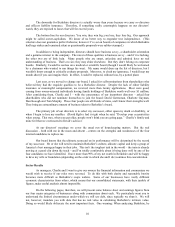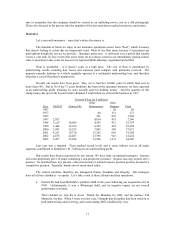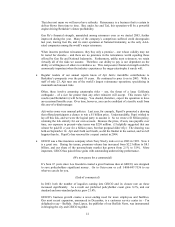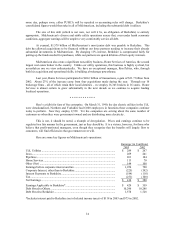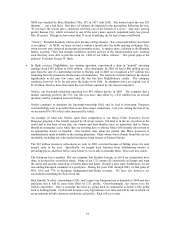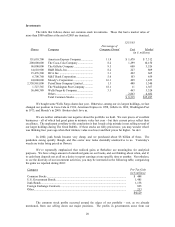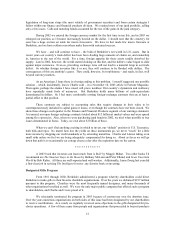Berkshire Hathaway 2003 Annual Report Download - page 14
Download and view the complete annual report
Please find page 14 of the 2003 Berkshire Hathaway annual report below. You can navigate through the pages in the report by either clicking on the pages listed below, or by using the keyword search tool below to find specific information within the annual report.
13
The key figure in this matter, however, was Governor George Pataki. His leadership and
tenacity are why Buffalo will have 2,500 new jobs when our expansion is fully rolled out.
Stan, Tony, and I – along with Buffalo – thank him for his help.
• Berkshire’ s smaller insurers had another terrific year. This group, run by Rod Eldred, John
Kizer, Tom Nerney, Don Towle and Don Wurster, increased its float by 41%, while
delivering an excellent underwriting profit. These men, though operating in unexciting ways,
produce truly exciting results.
* * * * * * * * * * * *
We should point out again that in any given year a company writing long-tail insurance (coverages
giving rise to claims that are often settled many years after the loss-causing event takes place) can report
almost any earnings that the CEO desires. Too often the industry has reported wildly inaccurate figures by
misstating liabilities. Most of the mistakes have been innocent. Sometimes, however, they have been
intentional, their object being to fool investors and regulators. Auditors and actuaries have usually failed to
prevent both varieties of misstatement.
I have failed on occasion too, particularly in not spotting Gen Re’ s unwitting underreserving a few
years back. Not only did that mean we reported inaccurate figures to you, but the error also resulted in our
paying very substantial taxes earlier than was necessary. Aaarrrggghh. I told you last year, however, that I
thought our current reserving was at appropriate levels. So far, that judgment is holding up.
Here are Berkshire’ s pre-tax underwriting results by segment:
Gain (Loss) in $ millions
2003 2002
Gen Re...................................................................................................... $ 145 $(1,393)
Ajit’ s business excluding retroactive contracts ........................................ 1,434 980
Ajit’ s retroactive contracts* ..................................................................... (387) (433)
GEICO...................................................................................................... 452 416
Other Primary ........................................................................................... 74 32
Total ......................................................................................................... $1,718 $ (398)
*These contracts were explained on page 10 of the 2002 annual report, available on the Internet at
www.berkshirehathaway.com. In brief, this segment consists of a few jumbo policies that are likely to
produce underwriting losses (which are capped) but also provide unusually large amounts of float.
Regulated Utility Businesses
Through MidAmerican Energy Holdings, we own an 80.5% (fully diluted) interest in a wide
variety of utility operations. The largest are (1) Yorkshire Electricity and Northern Electric, whose 3.7
million electric customers make it the third largest distributor of electricity in the U.K.; (2) MidAmerican
Energy, which serves 689,000 electric customers in Iowa and; (3) Kern River and Northern Natural
pipelines, which carry 7.8% of the natural gas transported in the United States.
Berkshire has three partners, who own the remaining 19.5%: Dave Sokol and Greg Abel, the
brilliant managers of the business, and Walter Scott, a long-time friend of mine who introduced me to the
company. Because MidAmerican is subject to the Public Utility Holding Company Act (“PUHCA”),
Berkshire’ s voting interest is limited to 9.9%. Walter has the controlling vote.
Our limited voting interest forces us to account for MidAmerican in our financial statements in an
abbreviated manner. Instead of our fully including its assets, liabilities, revenues and expenses in our
statements, we record only a one-line entry in both our balance sheet and income account. It’ s likely that


